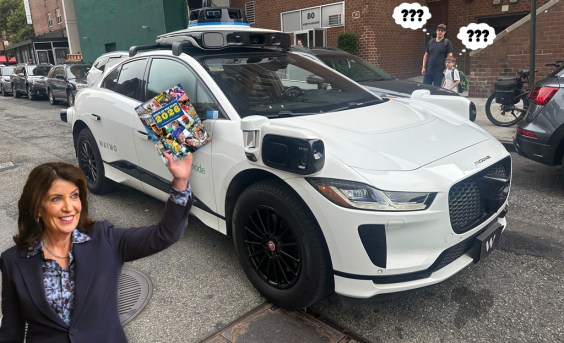
It could have been just another gathering of urban idealists, agreeing with each other about how great it would be to have more public space for people, and less for cars.
Except last night's NYC Streets Renaissance event, "A New Vision for the Upper West Side," featured renowned Danish planner Jan Gehl -- who, as has been mentioned a time or two on Streetsblog, has been hired by the city to help bring to life the long-held wishes of New Yorkers who want their streets to be welcoming communal destinations, or, at least, something more than loud, dirty, traffic-choked motoring facilities.
After introductions by Transportation Alternatives' Paul Steely White, The Open Planning Project's Mark Gorton and Transportation Commissioner Janette Sadik-Khan, Gehl joked that he was not yet at liberty to discuss his analysis of New York City streets, specific recommendations or much of anything else. Despite the warning, he teased the capacity crowd at the Jewish Community Center with vignettes of what the city could look like in the near and not-too-distant future. Ten years from now, Gehl said, New York could compete with Copenhagen, where nearly 40 percent of commuters travel by bike, for the crown of world's bike-friendliest city.

Whereas pedestrians now spend up to 25 percent of their walking time waiting on signal changes, Gehl sees a city where a presently accepted nod to auto supremacy like the button-activated walk light ("an application to cross the street," as he calls it) becomes an outmoded relic. Gehl's New York is one of flourishing street trees, attractive and functional street furniture, dedicated bus lanes, local outdoor art, complementary lighting, relaxed pedestrians and so many cyclists that the city will need to widen bike lanes to make room.
Specifically, Gehl looks to have big plans in the works for Broadway between Columbus Circle and the Battery. He also spent a bit of time discussing Fordham Road in the Bronx and Main Street in Flushing, noting that pedestrian volumes on these beleaguered outer borough thoroughfares are comparable to Times Square and some of the world's busiest urban promenades.

Gehl said his team was excited by New York City's wide streets and avenues, as they provide the space to easily accommodate wider sidewalks and new kinds of bus and bike lanes. The key, he said, is supply and demand; while cars will fill whatever space you give them, on-street or off, reducing auto capacity by even a small percentage would make a big difference to other users.
According to Gehl, the top priority for any city looking to humanize its infrastructure is to change the way citizens view the purpose and function of the city itself.
"New York has become very much a 'How to get from A to B' city," Gehl said. "It is not a law of nature that you have this much traffic."
Photos: Jonathan Barkey





